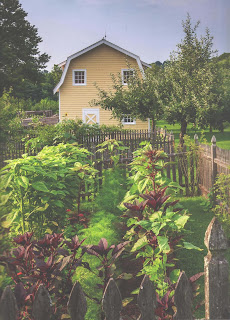"Private Edens" was published back in March of this year; I requested that my local public library purchase it and I believe that it will be enjoyed by other patrons of the library. The 21 gardens featured in the book are all very beautiful gardens in the eastern United States, most belonging to wealthy people who maintain them to a high standard.
Most of us would never have a chance to see these gardens, as they are mostly private gardens, and many readers will enjoy the photos and descriptions of them. Where else can one see the private gardens surrounding the house designed by Thomas Jefferson for James Monroe, after all?
 |
| The impressive facade of James Monroe's Virginia house, with 1920s-era gardens. |
Also included are a couple of beautiful southern boxwood gardens that are well-executed in the formal English style, as well as several historical farms that have been purchased and converted to gardens.
 |
| A lovely formal boxwood garden in Orange, Virginia. |
However, I must say that I was disappointed with this book for a number of reasons:
1. As someone who loves flowers, I was disappointed that most of the gardens seem to be shady gardens, filled with hostas, ferns and other foliage plants. There are a few photos of traditional perennial or mixed flower borders, but not many. Living in a sun-filled midwestern garden myself, I guess I envision farm-like places surrounded by open fields when I think of "country gardens." Although there are a couple in this book that fit that description, most of the gardens are surrounded by forests or deep within forests. Perhaps this is because these gardens are all in the eastern United States, where wealthy people prefer to live surrounded by dense trees?
 |
| Looking toward the Blue Ridge Mountains in Virginia, with one of the few flower borders (a double) pictured in the book. Overcast day + plus camera filter = shade even in open areas. |
3. At times the written material about each garden focuses too much upon the wealth and connections of the garden owners (who are not identified by name). The author seems to be overly impressed with the money and taste of the garden owners, and his descriptions of them are both fawning and snobbish. ("He's a local boy, scion of a family who .... She is the eldest daughter of the monarch of the tiniest of Far Eastern states..."; or one owner is "a former partner at one of Manhattan's most prestigious law firms, where he brokered a slew of headline-making deals"; that sort of thing.) Perhaps, again, this is simply an eastern thing (or perhaps the author thought he had to write in this manner to get the owners to open their gardens to him, and to us too) but to non-easterners it is distracting from the gardens and slightly distasteful.
4. There are, unfortunately, few photo captions, and those few are of a very general nature and do not identify any plants pictured in the photos. This renders the book far less useful to less-experienced gardeners who are looking for ideas to implement in their own gardens.
5. Upon doing a quick Google search about the author, I found that he owns one of the gardens (a beautiful one with a lovely video garden tour online) featured in this book, although this fact is not made known to readers (unless they notice a connection between the city and state of that garden in the book, and the same location in his bio on the back flap of the book). I'm not saying that there is anything dishonest about this, as no owners' names are given for any of the gardens in the book (and perhaps identification might have been construed as advertising, since he makes money from admissions to his garden), but it still seems a bit disingenuous to write so glowingly about a garden in the third person, when it is your own garden, unbeknownst to readers.
But "Private Edens" is still a beautifully photographed book that shows us some well-designed and well-maintained gardens in wealthy areas of the country. Generally, if you like eastern wealthy people's mostly shady gardens, you will enjoy this book. If you like traditional country gardens of the more floriferous kind, however, there is not much of that style pictured here.
 |
| This (an old dairy farm in North Salem, NY) is what a country garden should look like -- or at least the productive and less ornamental parts of a country garden. |

No comments:
Post a Comment